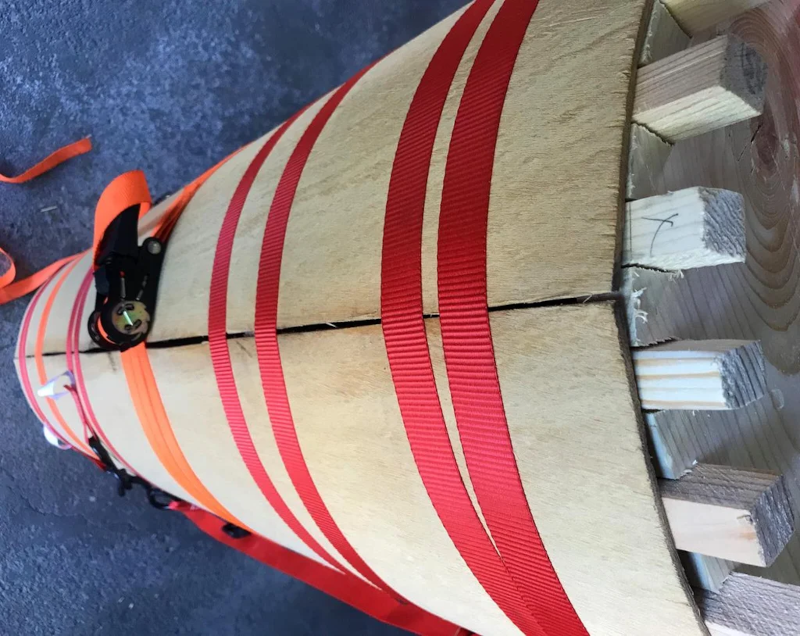To be clear, when we are talking about tubes, we mean ordinary cylinders, not vacuum-amplifying elements. With that out of the way, when we need a tube like that, we usually think of PVC or some other kind of pipe product. Or maybe we’ll 3D print what we need. But not [GregO29]. He made his tubes from plywood.
You can make tubes as small as 12 inches in diameter, and [GregO29] made some that were 16 inches. The first step was to make a mold or form. In this case, he elected to make a form that the tube-to-be wraps around. The plywood is thin 2-ply white birch. This makes it easy to shape.
The basic idea is to wrap the wood around the form and glue it. You hold it together with a strap until it dries. Then, you can add more layers until it is the thickness you need.
The real problem turned out to be removing the form once it was done. Why make a tube like this? In [Greg]’s case, he’s building a telescope, which is as good a reason as any to have a tube, we suppose.
We build a lot of things, but we always forget about plywood. It even mixes well with electricity.















Looks like he used regular thin plywood. There are special plywoods available for bending. The grain in all layers runs in the same direction, instead of alternating perpendicular layers.
That’s fine for the point of bending, but it makes for rather weak tubes, unless you laminate multiple sheets in alternating directions.
How so? There’s no pressure involved so no hoop stresses, and I can’t imagine buckling would be much of an issue in the tube aspect ratio Greg was making.
If you glue all the sheets in the same orientation, you have to choose whether you want your tube to split lengthwise or crosswise. Either way, it will be quite fragile, since veneer isn’t strong at all against bending along the grain. You’re supposed to either put it on top of some other wood, or cross-stack the layers yourself.
Yeah, it’s even called “bendy ply”.
Also you will get better results with ‘euro’ ply that has much thinner veneers than the generally available US stuff that is pretty coarse.
“To be clear, when we are talking about tubes, we mean ordinary cylinders, not vacuum-amplifying elements.”
Wooden tubes (valves) would be something.
I thought the same thing. You could turn some hardwood to the shape of a tube on a lathe, hollow it out, put a FET inside, and attach a standard tube base. An amplifier built like that with a wooden chassis would be both functional and beautiful. I would do it except that I don’t have a lathe.
It might have been here on Hackaday, but I remember reading about a process to create “transparent wood”.
Here’s the article: https://hackaday.com/2018/11/27/video-details-construction-of-transparent-wood/
kerfing the inside of the bend (longitudinal saw cuts partway through) allows tighter bends and if filled with epoxy quite strong. Built a cap for the box of a new datsun pickup in the early 80’s this way using 1/4″ luan underlayment with the top radius to about 4″ on top corners. At the time this was plywoood with veneer all through nor “solid core”. Lasted through that trucks long life.
Note that this is for a rather cool, massive and unusual telescope build. For smaller (though still rather large) telescopes, the classic cardboard concrete form tube (SonoTube, etc.) design is a lot simpler, perhaps lighter, can take a lot of damage, and probably damps vibration nicely. I have two Coulter telescopes based on them: an 8″ and a 13.1″. I don’t know when they were made, maybe in the 80s or the 90s, and they have held up great being tossed in the trunk. I couldn’t fit the 13.1″ in my car when I bought it so I cut the tube in half, and the halves bolt together.
I read the Instructible – at the end he dismisses Sonotube as being too easy to damage. Was left wondering if a couple of layers of fiberglass cloth laminated on the sonotube would have solved that problem without all of the woodworking. The high power rocketry folks do that all the time.
Sounds like the way the fuselage of one of WW2’s best planes was made.
Mosquito. Basically a long wooden tube that could take all sorts of damage and still function – a desirable feature at tens of thousands of feet and nasty types shooting at you with really big guns… :)